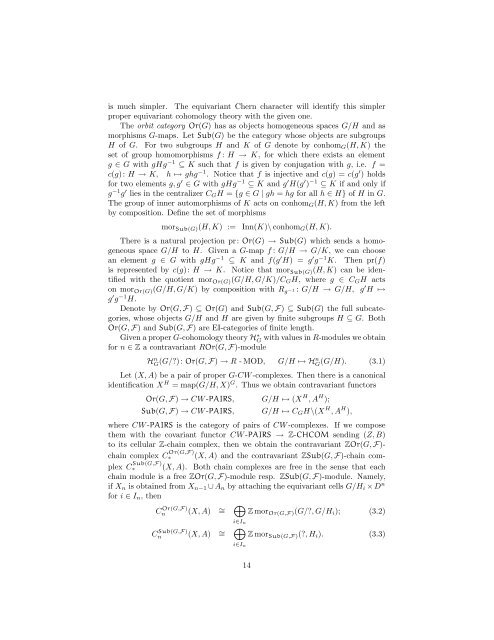Equivariant Cohomological Chern Characters
Equivariant Cohomological Chern Characters
Equivariant Cohomological Chern Characters
Create successful ePaper yourself
Turn your PDF publications into a flip-book with our unique Google optimized e-Paper software.
is much simpler. The equivariant <strong>Chern</strong> character will identify this simplerproper equivariant cohomology theory with the given one.The orbit category Or(G) has as objects homogeneous spaces G/H and asmorphisms G-maps. Let Sub(G) be the category whose objects are subgroupsH of G. For two subgroups H and K of G denote by conhom G (H, K) theset of group homomorphisms f : H → K, for which there exists an elementg ∈ G with gHg −1 ⊆ K such that f is given by conjugation with g, i.e. f =c(g): H → K, h ↦→ ghg −1 . Notice that f is injective and c(g) = c(g ′ ) holdsfor two elements g, g ′ ∈ G with gHg −1 ⊆ K and g ′ H(g ′ ) −1 ⊆ K if and only ifg −1 g ′ lies in the centralizer C G H = {g ∈ G | gh = hg for all h ∈ H} of H in G.The group of inner automorphisms of K acts on conhom G (H, K) from the leftby composition. Define the set of morphismsmor Sub(G) (H, K) :=Inn(K)\ conhom G (H, K).There is a natural projection pr: Or(G) → Sub(G) which sends a homogeneousspace G/H to H. Given a G-map f : G/H → G/K, we can choosean element g ∈ G with gHg −1 ⊆ K and f(g ′ H) = g ′ g −1 K. Then pr(f)is represented by c(g): H → K. Notice that mor Sub(G) (H, K) can be identifiedwith the quotient mor Or(G) (G/H, G/K)/C G H, where g ∈ C G H actson mor Or(G) (G/H, G/K) by composition with R g −1 : G/H → G/H, g ′ H ↦→g ′ g −1 H.Denote by Or(G, F) ⊆ Or(G) and Sub(G, F) ⊆ Sub(G) the full subcategories,whose objects G/H and H are given by finite subgroups H ⊆ G. BothOr(G, F) and Sub(G, F) are EI-categories of finite length.Given a proper G-cohomology theory HG ∗ with values in R-modules we obtainfor n ∈ Z a contravariant ROr(G, F)-moduleHG n (G/?): Or(G, F) → R - MOD, G/H ↦→ Hn G (G/H). (3.1)Let (X, A) be a pair of proper G-CW -complexes. Then there is a canonicalidentification X H = map(G/H, X) G . Thus we obtain contravariant functorsOr(G, F) → CW -PAIRS, G/H ↦→ (X H , A H );Sub(G, F) → CW -PAIRS, G/H ↦→ C G H\(X H , A H ),where CW -PAIRS is the category of pairs of CW -complexes. If we composethem with the covariant functor CW -PAIRS → Z-CHCOM sending (Z, B)to its cellular Z-chain complex, then we obtain the contravariant ZOr(G, F)-chain complex C∗Or(G,F) (X, A) and the contravariant ZSub(G, F)-chain complexC∗Sub(G,F) (X, A). Both chain complexes are free in the sense that eachchain module is a free ZOr(G, F)-module resp. ZSub(G, F)-module. Namely,if X n is obtained from X n−1 ∪ A n by attaching the equivariant cells G/H i × D nfor i ∈ I n , thenC Or(G,F)n (X, A) ∼ =⊕Z mor Or(G,F) (G/?, G/H i ); (3.2)i∈I n⊕Cn Sub(G,F) (X, A) ∼ = Z mor Sub(G,F) (?, H i ). (3.3)i∈I n14
















